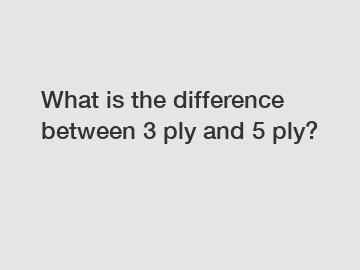What is the difference between 3 ply and 5 ply?
What is the difference between 3 ply and 5 ply?
When it comes to selecting the right type of plywood for a project, it's essential to understand the difference between various options available. Two common terms you may come across are "3 ply" and "5 ply." These terms describe the construction of the plywood and can impact its strength, durability, and suitability for specific applications. So, let's dive in and explore the dissimilarities between 3 ply and 5 ply plywood.
1. Plywood Construction:

The term "ply" refers to the individual layers or veneers that make up a sheet of plywood. In 3 ply plywood, there are three layers of wood veneer, while 5 ply plywood consists of five layers. Each layer is peeled from a log and is typically around 1/8 inch in thickness. These layers are then stacked, alternating the wood grain direction for added stability and strength.
2. Strength and Durability:
One significant distinction between 3 ply and 5 ply plywood is their strength and durability. With additional layers, 5 ply plywood tends to be stronger and more resilient compared to its 3 ply counterpart. The additional layers provide enhanced rigidity and stability, allowing it to withstand heavy loads and resist warping or sagging over time. Therefore, if your project requires a higher level of strength and durability, 5 ply plywood would be more appropriate.
3. Weight and Flexibility:
The number of ply layers in plywood can also affect its weight and flexibility. Since 3 ply plywood has fewer layers, it generally weighs less than 5 ply plywood. This makes it easier to handle and transport. Furthermore, the reduced number of layers also makes 3 ply plywood more flexible, which can be advantageous in certain applications where bending or shaping the material is necessary.
4. Cost Considerations:
Another factor to consider when choosing between 3 ply and 5 ply plywood is the cost. Generally, 5 ply plywood tends to be more expensive than its 3 ply counterpart. The additional layers and improved strength contribute to the higher price tag. However, the increased cost may be justified if your project demands the added durability and structural integrity that 5 ply plywood offers. On the other hand, if your project has less demanding requirements or you are on a budget, 3 ply plywood can be a cost-effective solution.
5. Application and Usage:
Lastly, the choice between 3 ply and 5 ply plywood depends on the specific application and usage. 5 ply plywood is typically favored for applications where strength and durability are crucial, such as furniture construction, flooring, and cabinetry. Its added stability and resistance to warping make it highly suitable for these purposes. 3 ply plywood, on the other hand, may find its application in lighter-duty projects such as interior wall paneling, prototypes, or temporary fixtures, where weight and flexibility take precedence over sheer strength.
In conclusion, knowing the difference between 3 ply and 5 ply plywood is vital for making informed decisions when it comes to material selection for your projects. While both options have their own advantages, the choice ultimately depends on factors like strength, weight, flexibility, cost, and application requirements. By understanding these distinctions, you can select the most appropriate type of plywood that suits your needs and ensures a successful outcome for your project.
Want more information on flatware sets wholesale, multi-ply stainless steel cookware supplier, stainless steel asparagus steamer? Feel free to contact us.
165
0
0

Comments
All Comments (0)